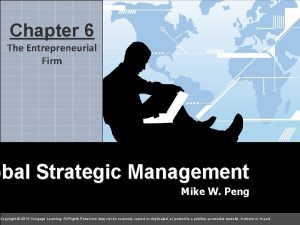Chapter 7 Managing and growing an entrepreneurial firm




























- Slides: 28

Chapter 7 Managing and growing an entrepreneurial firm Preparing for and evaluating the challenges of growth Strategies for firm growth

Preparing for and evaluating the challenges of growth Sustained growth is defined as growth in both revenues and profits over an extended period of time. According to a recent study by Brain&Company, an international consulting firm, only one in seven companies generated sustained, profitable growth. A rapid-growth firm is one that maintains a growth rate of at least 20 percent per year for five consecutive years. Most firms struggle with planning for and achieving sustained profit.

Example: For Hewlett-Packard, acquiring Compaq Computer Corporation contributed to the firm’s continuing commitment to growth. Especially in the short run, growth in sales revenue is an important indicator of an entrepreneurial venture’s potential to survive today and be successful in the future. The growth can threaten the stability of a firm’s operations in every area, from human resources to finance, if is not managed properly. Example: Just months after Amazon. com announced that it intended to become “a place where you can buy anything for anyone” (denoting an aggressive growth), the company laid off 15 percent of its workforce and started eliminating product lines.

Reasons for firm growth Ø Capturing Economies Of Scale: Economies of Scale occur when increasing production lowers the average cost of each unit produced. Ø Influence, Power and Survivability: Larger businesses usually have more influence and power than smaller firms in regard to setting standards for an industry, getting a “foot in the door” with major customers and suppliers, and garnering prestige. Example: A firm that stays small and relies on the efforts and motivation of its founder or a small group of people is vulnerable to the loss of their skills or interest in the firm. Once a firm grows, however, and has a larger staff and more products and services to offer, it usually gains momentum and is no longer as reliant on the efforts or motivation of a small number of founders or employees.

Ø Market leadership: Market leadership occurs when a firm is the number one or the number two firm in an industry or niche market in terms of sales volume. Ø Need to Accommodate the Growth of Key Customers: Sometimes firms are compelled to grow to accommodate the growth of a key customer or else risk losing this business. Ø Ability to Attract and Retain Talented Employees: The final reason that firms grow is to attract and retain high-quality personnel. It is natural for talented employees to want to work for a firm that can offer opportunities for promotion, higher salaries, and increased levels of responsibility. Growth is a firm’s primary mechanism to generate promotional opportunities for employees.

The Growth of an entrepreneurial firm brings certain advantages to the firm: higher access to the market, growth of the firm’s reputation, the opportunity of working with bigger and more experimented and important partners. The Growth of a firm requires efforts from its managers: the enlargement of the working capacity, hiring personnel, the need of managing a bigger firm, taking a larger risk. A firm’s actions in the direction of growth will generate responses from the competition. A series of competitive movements from the competition will be therefore generated, in form of “action” and “response” strategic movements. Many firms can not sustain an appropriate management of the growth process, because the managers are not aware of the characteristics of the successful firms in their growth strategies.

Attributes of Successful Growth Firms: § Growth-Oriented Vision: helps a firm crystallize the importance of growth for its stakeholders and ensures that its major decisions are made with growth in mind. Example: Vodafone is a company with a growth-oriented vision, it aims to be the world’s leading wireless telecommunications and information provider. Its growth objectives are: accelerated customer growth, geographic expansion, new services for all customers.

§ Commitment to Growth deals with the extent to which a firm is committed to pursuing growth. For growth to take place on a continual basis, it must be a deliberate choice made by the firm’s owners/entrepreneurs and managers. A recent survey of 402 fast-growth firms by Pricewaterhouse. Coopers confirmed that the number one quality that the participants in the survey identified as facilitating growth was “depth of management commitment” to firm growth. § Business Growth Planning is the process of setting growthrelated goals and objectives, then mapping out a plan to achieve those goals and objectives. Research shows that firms that plan in a conscientious, thorough manner increase their chances of reaching their growth objectives.

§ Participation in Business Partnerships (joint ventures, networks, consortia, strategic alliances, trade associations) accelerates a firm’s growth by providing it access to a portion of its partner resources, managerial talent and intellectual capacities. Example: In August 2000, Amazon. com and Toysrus. com announced the formation of a 10 -year strategic alliance to create a cobranded online toy and video game store. Prior to the agreement, both companies featured separate online toy stores. The alliance is structured so that the companies share responsibility. Toysrus. com is in charge of identifying, purchasing, owning, and managing the inventory of toys. Amazon. com handles Web site development, order fulfillment, customer service, and housing the inventory in its U. S. distribution centers.

Toysrus’s expertise is buying and selling toys, and Amazon. com’s expertise is managing a Web site and customer service. The partnership enables the seamless selling of toys and video games over the Internet by allowing both companies to focus on their areas of expertise. Amazon. com doesn’t have to hire employees to identify and purchase toys, and Toyrus. com doesn’t have to hire a staff to develop and maintain an e-commerce Web site. Each company is able to tap into its partner’s resources, thereby reducing the effect of the managerial capacity problem by lessening the resources they need to sell toys online.

§ Geographic Location facilitates the absorption of knowledge from external sources is typically to a firm’s advantage. By being physically located near similar firms, a company can gain access to these firms’ specialized suppliers, scientific knowledge, and technological expertise.

Growth Strategies The strategies for firm growth can be internal growth strategies and external growth strategies. Internal Growth Strategies Internal growth strategies rely on efforts generated within the firm itself, such as: -> new product development -> other product-related strategies -> international expansion The distinctive attribute of internally generated growth is that a business relies on its own competencies, expertise, business practices, and employees.

Advantages of Internal Growth Strategies: -> Incremental, even-paced growth. A firm that grows at an even pace can continually adjust to changing environmental conditions to fine-tune its strategies over time. -> Provides maximum control over the quality of its products and services during the growth process. Firms that grow through collaborative forms of growth must share the oversight function with their business partners. -> Preserves organizational culture. Firms are not required to blend their organizational culture with another organization. -> Encourages internal entrepreneurship. Firms are looking for new ideas from within the business rather than from outside stakeholders or acquisition targets. -> Allows firms to promote from within, which provides a powerful tool for employee motivation.

Disadvantages of Internal Growth Strategies: -> Slow form of growth. It does not permit a firm to achieve competitive economies of scale fast enough. -> Need to develop new resources. Some internal growth strategies, such as new product development, require a firm to be innovative and develop new resources. -> Investment in a failed internal effort can be difficult to recoup. -> Adds to industry capacity, and this can ultimately help force industry profitability down (for example, a restaurant chain that grows through geographic expansion may ultimately force profitability down by continuing to open new restaurants in an already crowded market).

New product development involves the creation and sale of new products (or services) as a means of increasing firm revenues. In many fast-paced industries, new product development is a competitive necessity. For example, the average product life cycle in the computer software industry is 14 to 16 months. For some companies, continually developing new products is the essence of their existence. The development of new products is a high-risk strategy. According to a Boston Consulting Group report, only 20 percent of new product launches with a budget of over $25 million succeed, and 90 percent of all product launches attract less than one percent market share.

The keys to effective new product and service development: -> Find a need and fill it: “Saturated” markets should be avoided. -> Develop products that add value for customers. -> Get quality right and pricing right: If the quality of a product and its price are not compatible, the product may fail and have little chance for recovery. -> Focus on a specific target market: The product’s manufacturer gets the opportunity to conduct a focused promotional campaign and select the appropriate distributors. -> Conduct ongoing feasibility analysis, even if the product is already launched on the market. This allows incremental changes to the product.

Reasons for new product’s failure: -> inadequate feasibility analysis -> overestimation of market potential -> bad timing ( introducing the product at the wrong time) -> inadequate advertising and promotion and poor service

Other Product-Related Strategies Improving an Existing Product or Service refers to enhancing quality, making it larger or smaller, making it more convenient to use, improving its durability, or making it more up to date. Increasing the Market Penetration of an Existing Product or Service : This strategy seeks to increase the sales of a product or service through greater marketing efforts or through increased production capacity and efficiency. An increase in a product’s market share is typically accomplished by increasing advertising expenditures, offering sales promotions, lowering the price, or increasing the size of the sales force. Increased market penetration can occur through increased capacity or efficiency or by expanding plant and equipment or by outsourcing a portion of the production process to another company.

Extending Product Lines. A product line extension strategy involves making additional versions of a product so that it will appeal to different clientele. Computer manufacturers provide a good example for this strategy. Each manufacturer sells several versions of its computers, that typically represent better alternatives based on processor speed, memory capacity, monitor size, graphic capabilities, and other features. Geographic Expansion refers business growth by simply expanding from their original location to additional geographic sites. This type of expansion is most common in retail settings. The keys to successful geographic expansion follow: -> Perform successfully in the initial location -> Give the same amount of attention to the new locations as to the initial ones (training and oversight for the employees) -> Efforts for raising the interest for the business inn the new location’s community (don’t assume that if something works in one community, it will automatically work in another)

International expansion Because of the market saturation phenomenon, entrepreneurial firms have become increasingly active in foreign markets. The most important issues that should consider in pursuing growth via international expansion are: Ø Assessing a Firm’s Suitability for Growth Through International Markets: management commitment to entering international markets, depth of international experience, the degree in which the products or services are suitable for overseas markets, distribution issues, financing export operations. Ø Foreign Market Entry Strategies

External Growth Strategies External growth strategies rely on establishing relationships with third parties and result in a more fast-paced, collaborative approach toward growth than the slower-paced internal strategies. Advantages of external growth strategies: ü Reducing competition. If a firm acquires a competitor, it reduces its competition ü Getting legitimate access to the proprietary products or services, in case of acquisitions or alliances ü Gaining access to new products and markets, through acquisition, alliances, franchising ü Access to technical expertise ü Economies of Scale. The combination of two or more previously separate firms leads to economies of scale.

Disadvantages of External Growth Strategies: ü Incompatibility of top management ü Clash of corporate culture ü Operational problems, due to the incompatibility between their equipment and business processes ü Loss of organizational flexibility ü Increased business complexity External Growth Strategies: -> Acquisitions -> Licensing -> Strategic alliances and Joint ventures -> Franchising

Acquisitions In most cases, the entrepreneurial firm is the target, meaning that it is the firm being acquired, but not always. Acquiring another business can fulfill several of a company’s needs, such as expanding its product line, gaining access to distribution channels, achieving competitive economies of scale, or expanding the company’s geographic reach. Licensing is the granting of permission by one company to another company to use a specific form of its intellectual property under clearly defined conditions. It can be a very effective way of earning income, particularly for intellectual property-rich firms, such as software and biotech companies. The terms of license are negotiated and the licensee (the company purchasing the right of using the property) pays the licensor (is the company that owns the intellectual property) an initial payment plus an ongoing royalty for the right to use the intellectual property. Entrepreneurial firms often press for a relatively large initial payment as a way of generating immediate cash to fund their operations.

Advantages of licensing for entrepreneurial firms: ü generating income ü spreading the risk and cost of developing new technologies

Strategic Alliances and Joint Ventures Technological alliances and marketing alliances are two of the most common forms of alliances. Technological alliances feature cooperation in research and development, engineering, and manufacturing. Research-and development alliances often bring together entrepreneurial firms with specific technical skills and larger, more mature firms with experience in development and marketing. Marketing alliances typically match a company with a distribution system with a company that has a product to sell in order to increase sales of a product or service. The alliances are particularly attractive to entrepreneurial firms, which often don’t have the financial resources or time to develop all the competencies they need to bring final products to market quickly.

Example: At the beginning of its activity, Dell Inc. didn’t have the money to build the components themselves. Therefore, Michael Dell decided to buy components from specialists and to focus on what they did best – designing and delivering solutions and systems directly to customers. The firm forged strategic alliances with the components distributors.

Advantages of Participating in Strategic Alliances: Ø Gain access to a particular resource (capital, employees with specialized skills, modern production facilities) Ø Economies of scale: in many industries, high fixed costs require firms to find partners to expand production volume as a means of developing economies of scale Ø Risk and cost sharing Ø Gain access to a foreign market: Partnering with a local company is often the only way to gain access to a foreign market Ø Learning : The firms have the opportunity to learn from their partners Ø Speed to market: Firms with complementary skills partner to increase speed to market in hopes of capturing first-moving advantages Ø Neutralizing or blocking competitors: firms can gain competencies and market power that can be used to neutralize or block the moves of a competitor

Disadvantages of Participating in Strategic Alliances and Joint Ventures Ø The necessity of partnership management Ø Loss of proprietary information Ø The failure rate for strategic alliances and joint ventures is high Ø The corporate cultures of alliance partners may clash, making the implementation and management of the alliance difficult Ø Loss of organizational flexibility
 Growing and internationalizing the entrepreneurial firm
Growing and internationalizing the entrepreneurial firm Managing human resources in small and entrepreneurial firms
Managing human resources in small and entrepreneurial firms Employee selection
Employee selection Managing human resources in small and entrepreneurial firms
Managing human resources in small and entrepreneurial firms Management information system managing the digital firm
Management information system managing the digital firm Management information systems managing the digital firm
Management information systems managing the digital firm Managing the digital firm
Managing the digital firm Managing knowledge in the digital firm
Managing knowledge in the digital firm Chapter 15 manifest destiny and the growing nation
Chapter 15 manifest destiny and the growing nation 7 pathways
7 pathways Chapter 33 entrepreneurial concepts answers
Chapter 33 entrepreneurial concepts answers A growing sense of nationhood answer key
A growing sense of nationhood answer key Growing up quotes in to kill a mockingbird chapter 1-5
Growing up quotes in to kill a mockingbird chapter 1-5 Entrepreneurial strategy and competitive dynamics
Entrepreneurial strategy and competitive dynamics Entrepreneurial motivation behaviour
Entrepreneurial motivation behaviour Entrepreneurial mind frame heart flame and gut game meaning
Entrepreneurial mind frame heart flame and gut game meaning Entrepreneurial and intrapreneurial mind
Entrepreneurial and intrapreneurial mind Chapter 8 managing stress and anxiety
Chapter 8 managing stress and anxiety Chapter 4 managing stress and coping with loss notes
Chapter 4 managing stress and coping with loss notes Chapter 6 managing weight and body composition
Chapter 6 managing weight and body composition Most fad diets do follow the mypyramid guidelines.
Most fad diets do follow the mypyramid guidelines. Chapter 11 lesson 2 body image and eating disorders
Chapter 11 lesson 2 body image and eating disorders Managers and management chapter 1
Managers and management chapter 1 Building vocabulary: diet categories and feeding mechanisms
Building vocabulary: diet categories and feeding mechanisms Chapter 6 managing weight and body composition
Chapter 6 managing weight and body composition Types of jaycustomers
Types of jaycustomers Chapter 11 managing weight and eating behaviors answer key
Chapter 11 managing weight and eating behaviors answer key Chapter 4 managing stress and coping with loss lesson 1
Chapter 4 managing stress and coping with loss lesson 1 Chapter 14 designing and managing services ppt
Chapter 14 designing and managing services ppt


















































